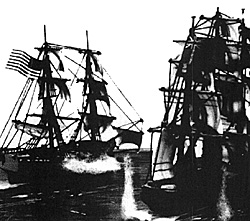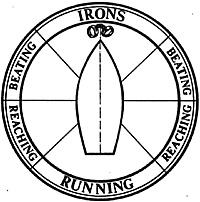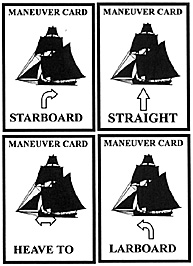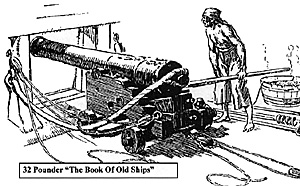 Turn Sequence
Turn Sequence
- 1. Place Maneuver & Sail Settings Cards
2. Mark Crew Assignments
3. Dice For Initiative & Reload
4. Movement & Firing
5. Grappling & Boarding Actions
6. Morale & Sinkings
| Rating Officers & Crews | ||||||
|---|---|---|---|---|---|---|
| Die | Captain | 1st LT. | Master | Gunner | Crew | Rating |
| 1-2 | Landlubber | Midshipman | Helmsman | Powder Monkey | Swabs | 0 |
| 3-5 | Sea Dog | Competent | Navigator | Sure Shot | Seaman | 1 |
| 6 | Old Salt | Oak | Grand Mariner | Marksman | Tars | 2 |
| Officer and crew ratings may be established by scenario design or by rolling a six sided ie per chart. Mark ratings on ship log. | ||||||
Initiative
The order of ship movement is determined by an initiative roll (add Initiative modifier to roll) with the highest roll moving first.
Modifiers
Initiative Modifier: Add Master and Crew ratings together. Reload Modifier: Add the Gunner and Crew ratings together. Morale Modifier: Add the Captains (or whoever commands) and the Crew ratings together.
SAILING
 The essential considerations for sailing in Privateers is the determination of the angle of the ship to the direction from which the wind blows, and the sail setting of the ship.
The essential considerations for sailing in Privateers is the determination of the angle of the ship to the direction from which the wind blows, and the sail setting of the ship.
Ship In Irons: Wind straight ahead to 45 degrees either side of the bow. No movement allowed.
Ship is Beating: Wind from 45 degrees to 90 degrees from straight ahead to either side of the bow.
Ship Is Broad Reaching: Wind from 90 degrees to 45 degrees from either side of the stern.
Ship Is Running: Wind from directly behind to 45 degrees from either stern.
Sail Settings
 Each turn a player should mark his ship with a sail settings card which determines the speed
at with the ship can move that turn. A player may increase or decrease his ships speed by only
one level each turn.
Each turn a player should mark his ship with a sail settings card which determines the speed
at with the ship can move that turn. A player may increase or decrease his ships speed by only
one level each turn.
No Sail: The normal setting for a ship at anchor. When a ship is not at anchor with no sail set (Example - the ship has lost its rigging or masts), the ship will drift in inches per a six sided dice roll down wind.
Fighting Sail: The slowest sail setting, and also the ideal sail setting for firing the ship's guns with no negative modifier for firing. The first sail setting a ship may adopt from anchor setting, and the speed all jury rigged ships must sail at. This sail setting requires one crew per mast, including bow sprit.
Medium Sail: The ship fires its guns with a -1 modifier at this setting. A ship may have been moving at fighting sail, or full sail speeds the previous turn. Requires two crew per mast, including bow sprit.
Full Sail: The fastest sail setting. No firing is allowed at this speed. A ship may move at full speed if it was at medium sail the previous turn. Requires three crew per mast, including the bow sprit.
Sailing Rates
To determine the speed of movement that is allowed for each ship, check the ship log which will list sailing rates for each wind direction. The listing will be shown as 8-10-12 or fighting sail, medium sail and full sail speed. The sailing speed will differ from ship to ship depending on the way the sails are rigged and the direction on the wind.
 Maneuvers
Maneuvers
In addition to playing the sailing cards to establish speed, a player must also play his direction setting card for each turn of play.
Straight: Ship must move in a straight line for its entire movement allotment even if it would result in a collision.
Starboard: Ship must move half its movement allotment straight ahead, then by pivoting by its bow, and swinging its stern, the ship may be angled up to, but not exceeding 45 degrees to starboard (the right, you lubber!). The ship then moves its second half of its movement straight ahead.
Larboard/Port: Same procedure as turning to starboard, except you turn to the left.
Heaving To: A ship that is beating moves half its movement allotment, then pivots by its stern until it is broadside to the wind, and comes to a stop. To start moving again, the ship sails its first leg at fighting sail speed, then its second leg at whatever sail setting the ship was at before it hove to.
 Tacking: When a ship's turning movement requires
it to cross the wind it is said to be tacking. The ship moves its first
leg of movement while beating. It then pivots from the bow,
swinging its stern until the bow is directly pointed into the wind.
This ends the movement allowed for this turn. On the next turn,
the player rolls a 12 sided die, a modified roll (use initiative
modifier) of four or above, and the maneuver is successful. The
stern is pivoted another 45 degrees, and, and the ship moves half
its allowable distance. If the maneuver is unsuccessful, the ship is
taken aback. Roll for losing a mast at 3 of 12 probability. This
procedure is used for all square-rigged vessels. Fore-and -aft rigged
vessels complete the maneuver in one turn, and need not make a
dice role.
Tacking: When a ship's turning movement requires
it to cross the wind it is said to be tacking. The ship moves its first
leg of movement while beating. It then pivots from the bow,
swinging its stern until the bow is directly pointed into the wind.
This ends the movement allowed for this turn. On the next turn,
the player rolls a 12 sided die, a modified roll (use initiative
modifier) of four or above, and the maneuver is successful. The
stern is pivoted another 45 degrees, and, and the ship moves half
its allowable distance. If the maneuver is unsuccessful, the ship is
taken aback. Roll for losing a mast at 3 of 12 probability. This
procedure is used for all square-rigged vessels. Fore-and -aft rigged
vessels complete the maneuver in one turn, and need not make a
dice role.
Anchor: If a ship has heave to, or was at sail setting fighting sail and plays no sail setting card it can drop anchor. The ship may move in the same direction as it had the previous turn up to 3" before dropping anchor, or it may drop anchor without moving. The ship then pivots until its bow is pointed directly into the wind.
Weighing Anchor: Assign the desired number of crew to raise anchor. Roll 12-sided die, subtract crew from roll, and the result is the number of turns that it will take to raise the anchor. If crew equal or exceed the number rolled, it takes one full turn to raise anchor. The next turn, the ship will pivot 45 degrees away from the wind, and start movement at fighting sail beating into the wind. Any maneuver card may be played.
Crew Assignments
Each turn, a captain must determine which tasks the crew will perform and record them on the ship log. The number of crew available can be divided to do the following assignments.
Sailing: As described per sail setting and maneuver, varying numbers of crew must be assigned to each mast. If crew numbers needed are not available, the maneuver cannot be done.
Firing Guns: For cannon to be fired, it must be manned by one crew.
Pumping: Once a ship has received water line damage by critical hit, or sustained 3/4 hull damage, the pumps must be manned to keep the ship afloat. Two crew members must be assigned every turn or the ship suffers an additional 5 points damage to the hull per turn un-pumped.
Fires: A fire does 5 points damage per turn that they bum, and become increasing;y difficult to extinguish. It takes a modified dice roll of 8 on a 12 sided die to put out a fire the first turn, 10 on the second turn and 12 on the third turn. If a fire is not extinguished past the third turn, then the ship is engulfed and bums up. The captain may assign as many crew to the task of putting out the fire with each crew assigned counting as one modifier. For example on the first turn with 4 crew members assigned the fire will be put out on a roll of four or higher.
Damage Control: Crew may need to be assigned to clear wreckage, such as when a mast falls uncleanly and drags over the side of the ship. Such damage will take a modified dice roll of 10 on a 12 sided dice to be cleared.
Jury Rigging: For a mast to be jury rigged, a modified roll of 12 on a 12 sided dice must be made. Rolls may be made each turn until successful.
Ship's Boats: It takes two crew men to lower or recover a ship's boat. The task takes one full turn and may never be attempted on any turn the ship is moving.
Grappling: Crew may be assigned to throw grapples any time an enemy ship is hull to hull or has collided. Each crew assigned will attempt to grapple. Roll a 12 sided dice for each crew assigned with an 8 or better needed. Crew may be assigned to cut grapples at the same chance.
Marksmen: One crew man may be assigned to each mast to act as a marksman (marines will be used for this task if available). They may only fire within short range, with 1- 3 on a 12-sided die needed for a hit (1 -4 for a marine). Roll a six sided dice for damage: 1-5 crew, 6 officer, roll for officer.
Boarding Parties and Defenders: Only crew that have no assignments on any given turn are available fore boarding actions. The following value is given to each member in six-sided dice:
- Crew 1 die/man
Officers 2 die/man
Marines 3 die/man
The number of dice per side is determined and each player rolls the dice with 1's being hits. Casualties are removed on both sides. If marines are available casualties will be extracted at an even rate between marines and crew. If an officer is present, roll 1 die per officer to see if they were part of the casualties. A one on the dice and the officer is removed as part of the total casualties.
A tie will result in a boarding combat the next turn. A win for the defender and the boarders must retreat the next turn. A win for the boarders and the defender must roll for morale to see if he strikes his colors. If a defender passes his morale and the boarding player wishes to continue combat, another round is fought the next turn. Both sides may increase the number of crew, marines, and officers in the next turns combat by assigning more crew to the action.
Cannon Fire
 1. Each gun bears a 45 degree arc per gun port. Only guns that bear on a target may fire.
Swivels, due to mounting, have a 180 degree arc of fire, and some may have a 360 degree arc
depending on the mounting location.
1. Each gun bears a 45 degree arc per gun port. Only guns that bear on a target may fire.
Swivels, due to mounting, have a 180 degree arc of fire, and some may have a 360 degree arc
depending on the mounting location.
2. It requires one crew to man and individual gun. Guns that are unmanned cannot be fired.
3. For game purposes, guns are considered to be loaded on the first broadside or firing. After the first shot, guns must be loaded to fire again. A modified dice roll of 7 or more on a 12 sided die is needed to be loaded. All guns within a vessel or fortification are loaded when a seven or higher is rolled. Independent batteries on land roll individually. The gunners and crew ratings combined give you the reload modifier. Guns may be deemed to be unloaded at the start of game by scenario design.
4. Guns may be fired as one broadside, or may be fired as each gun bears on an enemy (such as when crossing a ship's stern).
5. To fire guns, determine number for hits, consult range and roll a 12 sided dice per gun firing. The player must state before firing if he is firing low (ship's hull, all land targets), or firing high ( at ship's mast and rigging). As each hit is made, the player should place the appropriate number of six-sided damage dice aside per type of gun scoring the hit.
Damage Dice (6 Sided)
- Swivel Guns: 1 Die
Light Guns: 1 Die
Medium: 2 Die Guns
Heavy Guns: 3 Die
Extra Heavy: Per Scenario
Firing Charts
| Cannon & Swivel Guns (6 Sided Dice) | |||
|---|---|---|---|
| Range | Distance | FireLow | Fire High |
| Short | 0-12" | 1-9 | 1-6 |
| Medium | 12"-24" | 1-6 | 1-3 |
| Long | 24"-36" | 1-3 | N/A |
| Land Based Guns Add 12" To Each Range | |||
Firing Modifiers
- Gunner Sights Gun*: +2
No Sail: +1
Fighting Sail: None
Medium Sail: -1
Full Sail: No Fire Allowed
Double Shot**: +1/2 Damage Dice
Stern Rake: 2x Damage Dice
Bow Rake: +1/2 damage Dice
* When Gunner is assigned, gun will reload with 6.
** Firing double shorted guns requires modified reload roll of 10 or more.
Critical Hits
Critical hits are determined by the six sided damage dice, All damage dice are rolled at the same time, with any double ones (snake eyes) being a critical hit. Only one critical hit per dice toss is counted, All other ones are totaled with the hull or rigging point damage for the round.
| Critical Hits (12 sided Dice) | |
|---|---|
| Firing Low | Firing High |
| 1 Captain | 1 Captain |
| 2 1st Lt. | 2 1st Lt. |
| 3 Master | 3 Master |
| 4 Gunner | 4 Mast |
| 5 Mast | 5 Mast |
| 6 Fire | 6 Fire |
| 7 Rudder | 7 Helm/Tiller |
| 8 Helm/Tiller | 8 Mast |
| 9 Water Line | 9 2x Rigging Pts |
| 10 Water Line | 10 2x Rigging Pts |
| 11 2x Hull Pts | 11 2x Rigging Pts |
| 12 2x Hull Pts | 12 2x Rigging Pts |
Officer hits: Lose modifier
Rudder: Ship will not sail into the wind
Helm/Tiller: May not alter course next turn, must assign 2 crew to tiller deck.
Damage
| Damage Dice Table | ||||
|---|---|---|---|---|
| Dice Roll | Shot & Grape | Swivel/Grape | Ball Low | Ball High |
| 1 | 1 Hull Point | Crew | 1 Hull Point | 1 Rigging Point |
| 2 | 2 Hull Points | Crew | 2 Hull Points | 2 Rigging Points |
| 3 | 3 Hull Points | Crew | 3 Hull Points | 3 Rigging Points |
| 4 | Crew | Crew | 4 Hull Points | 4 Rigging Points |
| 5 | Crew | Crew | Crew | Crew |
| 6 | Gun+ | Ofricer* | Gun+ | Crew |
| *Roll for which officer
+Heavy gun first then next largest/ alternate sides | ||||
Officer Hits
- 1 Captain
2 1st Lt.
3 Master
4 Gunner
5 Master & Gunner
6 1st Lt & Master
Rigging Damage
When shooting hall high rigging damage will be based on the roll o the damage dice. For example on a roll of 2 and 3 there would be points of rigging damage. Mark damage on the ship log.
Accumulated rigging damage reduces a ship speed capabilities by level for each 1/3 of rigging points lost. For example after a ship losses 1/3 rigging point it cannot sail at full sail but only Medium and Fighting sail. When damage exceeds the total rigging points no movement is allowed.
Lost of a mast reduces speed capabilities by one level on three masted ships and two levels on two masted ships. No movement is allowed if all masts are lost.
Hull Damage
When shooting ball/low or shot/grape hull damage will be determined by the damage dice roll. For example on a roll of 1 2 & 3 with three damage dice, the hull damage would total 6 points. Mark hits on ship log. Lost of each 1/3 hull points reduces the ships speed capability by one level. Once a ships hull points have been expended, the ship will sink
Collisions
Ramming boat throws a 6 sided dice for hull damage, and also throws a 12 sided dice for entanglement. On a roll of 8-12 the ships are entangled. Rammed boat throws ace per ramming ship's speed: 1 /fighting sail, 2/medium sail, and 3/full sail for damage.
Morale
When to check
- Captain/Commander hit
Ship on fire
Each turn hull points +3/4 damage
Each turn ship rigging points + 3/4 damage
Stern rake taken
Every turn crew casualties exceed 1/2
Defender losses boarding action
Morale Results Use 12 Sided Die
- 1-6: Make [Pass]
7: Fail by One [Disordered]
8-12: Fail by 2 or More [Strike]
Morale Modifiers (Add or Substract From Dice Roll)
- Captain "Landlubber" 0
Captain "Sea Dog" -1
Captain "Old Salt" -2
Crew "Swobs" 0
Crew "Seaman" -1
Crew "Tars" -2
Crew is Disordered +1
9 Ship Charts for Privateers (extremely slow: 642K)
Back to MWAN #108 Table of Contents
Back to MWAN List of Issues
Back to MagWeb Magazine List
© Copyright 2000 Hal Thinglum
This article appears in MagWeb (Magazine Web) on the Internet World Wide Web.
Other military history articles and gaming articles are available at http://www.magweb.com